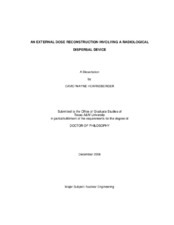| dc.description.abstract | Recent events have underscored the need for the United States government to provide streamlined emergency response procedures and subsequent dose estimations for personnel responding to incidents involving radioactive material. Indeed, the National Council on Radiation Protection and Measurements Report No. 138 (NCRP 2001) indicates that exposures received by first responders will be important for a number of reasons, including planning for the appropriate use of key personnel in an extended emergency situation. In response, the Department of Homeland Security has published Protective Action Guides (DHS 2006) to help minimize these exposures and associated risks. This research attempts to provide some additional radiological exposure knowledge so that an Incident Commander, with limited or no information, can make more informed decisions about evacuation, sheltering-in-place, relocation of the public, turn-back levels, defining radiation hazard boundaries, and in-field radiological dose assessments of the radiation workers, responders, and members of the public. A method to provide such insight begins with providing a model that describes the physics of radiation interactions, radiation source and geometry, collection of field measurements, and interpretation of the collected data. A Monte Carlo simulation of the model is performed so that calculated results can be compared to measured values. The results of this investigation indicate that measured organ absorbed doses inside a tissue equivalent phantom compared favorably to the derived organ absorbed doses measured by the Panasonic thermoluminescence dosimeters and with Monte Carlo ‘N’ Particle modeled results. Additionally, a Victoreen 450P pressurized ion chamber measured the integrated dose and these results compared well with the Panasonic right lateral TLD. This comparison indicates that the Victoreen 450P ionization chamber could potentially serve as an estimator of real-time effective dose and organ absorbed dose, if energy and angular dependence corrections could be taken into account. Finally, the data obtained in this investigation indicate that the MCNP model provided a reasonable method to determine organ absorbed dose and effective dose of a simulated Radiological Dispersal Device in an Inferior-Superior geometry with Na99mTcO4 as the source of radioactive material. | en |


